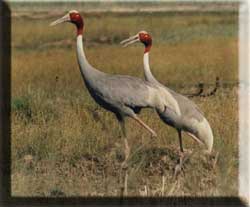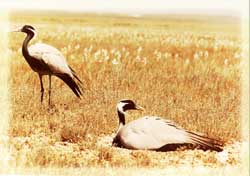
 |
| Birding
is a delightful hobby you can enjoy at any age or time of year. It makes
no difference whether you are alone or in a group, living in the city or
the country, as long as you have eyes to see and ears to hear. Birds are everywhere. You can choose to watch one pair feeding in your backyard, or thousands at migratory stops in a marsh. The variety of calls, colors, sizes, and songs is endless, and provides a great deal. You can make. |
 |
Where and When?
|
|
| Birds,
like people, live in communities. A biological community, such as a wetland
or a prairie, is a network of plants and animals interacting with each other
within a given area. Environmental conditions like hydrology, climate and
soils also shape the community, as do periodic events such as fire, flood,
and wind. In a healthy community, each organism depends on several others
for its continued survival. Each species of bird requires food, water, nesting sites, and other resources. The area, which provides these essential resources, is called the species' habitat. In general, a greater variety of birds are found in areas where two or more communities meet, since this area will contain diversity of habitats. For instance in LCS, you may find Sarus Crane, cormorants, ducks etc feeding on wetland, next to wetland cuckoos sing a song, parakeets perch on tree, several forest birds roost in the forest. In the nearby forest, you may watch hen harrier, pied harrier and storks roost in the grasslands. Around the LCS, there are farmlands where you may find storks, cranes, bee eaters, kingfishers, etc with their much joyful activities. Birds are most active at sunrise and sunset in the spring and early summer. For the best birding, get up at sunrise, or take an evening walk. We have recorded over 210 species of birds in and around the LCS at Lumbini |
|
Sn.
|
Scientific name
|
Common name
|
IUCN category
|
CITES list
|
| 1 1.1 1.2 2. 2.1 2.2 3. 4. 5. 6. 7. 7.1 7.2 7.3 7.4 7.5 7.6 8. 8.1 8.2 8.3 9. 10. 11. 12. 13. 14. 15. |
Balearica pavonina B. p. pavonina B. p. ceciliae Balearica regulorum B. r. gibbericeps B. r. regulorum Anthropoides paradisea Anthropoides virgo Bugeranus carunculatus Grus leucogeranus Grus canadensis G. c. canadensis G. c. rowani G. c. tabida G. c. pratensis G. c. pulla G. c. nesiotes Grus antigone G. a. antigone G. a. sharpii G. a. gilli Grus rubicundus Grus vipio Grus monachus Grus grus Grus americana Grus nigricollis Grus japonensis |
Black Crowned Crane West African Crowned Crane Sudan Crowned Crane Grey Crowned Crane East African Crowned Crane South African Crowned Crane Blue Crane Demoiselle Crane Wattled Crane Siberian Crane Sandhill Crane` Lesser S.C. Canadian S.C. Greater S. C. Florida S. C. Mississippi S. C. Cuban S. C. Saurs Crane Indian S. C. Eastern S. C. Australian S. C. Brolga White-naped Crane Hooded Crane Eurasian Crane Whooping Crane Black-necked Crane Red-necked Crane |
Vulnerable Endangered Vulnerable Vulnerable Vulnerable Endangered Critically Endg. Lower Risk Endangered Endangered Lower Risk Lower Risk Lower Risk Lower Risk Lower Risk Critically Endg. Critically Endg. Endangered Endangered Endangered Data Deficient Lower Risk Vulnerable Vulnerable Lower Risk Endangered Vulnerable Endangered |
Appendix-II |
 |
||
| There
are still a lot of works to be done and subjects to be studied in and around
Lumbini Crane Sanctuary. For your remembrance, this is only the non-government
Bird Sanctuary in Nepal, which is trying to demonstrate that any endangered
species like Sarus Crane can be conserved by creating artificial wetlands
(major Cranes' habitat) and managing them, which certainly require great
support from the local people, NGOs and INGOs. There
it is urgently needed to conduct some scientific studies of Sarus Cranes
and some studies on Cranes and people relationship. We would be more thankful
to any individuals or organization if they are interested to involve with
us to complete our recent tasks. We are also trying to explore about Buddhist philosophy on nature conservation. Lord Buddha born in nature, grew up in nature and attained perfect enlightenment in nature by eliminating all his influxes. So, he has greater intimacy to nature. We are interested to find out that what the Buddhism tell about today's modern world and to overcome the problems. |
| |
· By becoming a benefactor
of Lumbini Crane Conservation Center. · By volunteering your services to Lumbini Crane Conservation Center. · By just talking to others about our works. · Or just by getting some information about our works in Lumbini Crane Sanctuary. · By providing some financial grants to continue our works. · By conducting educational program to the people around the Sanctuary. · By providing educational materials for the people around the Sanctuary. · By visiting the Lumbini Crane Sanctuary and put some constructive efforts to build the Sanctuary more effectively. |
|
For Further Details Contact
Rajendra N. Suwal/ Prabin K. Joshi Lumbini Crane Conservation Center Trideve Marg, Thamel, Kathmandu Phone: 01-421860 PO Box- 12601, Kathmandu Field Office: Lumbini Phone:071-80186 Email: cranesnp@ccsl.com.np |